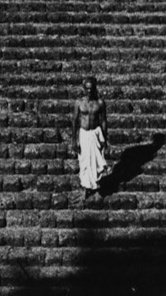Bathing Tank in the East Wing of the Home of the Zamorins of Calicut
1975
T.S. Nagarajan, Indian, born 1932
Black and white photographs of bathing tanks in Kerala always make my hair stand on end. Although I do not think this is specifically because the image is devoid of colour, the starkness of its tone does cut through any romanticism I may have for the Kerala landscape.
From the early 12th century till 1766, Calicut, or Kozhikode as it is known in Malayalam, was a small kingdom in what is today Kerala, ruled by a clan of Nair chieftains who were known as Samuthiris, a title later anglicised to Zamorin. The Zamorins occupy a particularly prominent place in Kerala lore, as the last Zamorin lost his throne and his kingdom when it was invaded by Hyder Ali of Mysore in 1766 in a move that stunned all of Kerala, a land that had hitherto never been invaded.
Most of what today forms the Indian state of Kerala is geographically isolated from the rest of India with the Arabian Sea on one side, and the mountains of the Western Ghats on the other. Kerala’s isolation is significant not only from the perspective of the defence of its kingdoms but more so when understanding the development of its society – based on the hierarchical system of caste oppression it borrowed from India, but which festered within Kerala over centuries into a society the extent of whose violence was foreign even to the mainland.
This is a photograph of the bathing tank adjoining the palace/home of an erstwhile ruling family in Kerala. It is interesting to note that the Zamorins were Nairs, – a caste that was second only to the Namputhiri Brahmins at the top of Kerala’s caste hierarchy, – and yet even they had to observe ritual distance from the Brahmins. The photographer who made this photograph, TS Nagarajan, was himself a Brahmin (he was the younger brother of the famed photographer TS Satyan). Nagarajan was not a Malayali but was in fact from Mysore.
In a society where caste permeated every aspect of everyday life, the bathing tank occupied a central place within the governing laws of ritual pollution and purity. If a person belonging to a ‘polluting’ caste came too close (sometimes within fifty feet) of a Brahmin, they could be violently punished, and even killed, without punishment. The Brahmin would then have to take a ritual bath to cleanse them from the pollution of contact.
The photograph is a photograph, it does not reveal nor conceal anything.
But I see the ominous shadow of the coconut palm above the tank, and the two figures clad in pristine white, – a colour long held to be emblematic of Kerala society – walking down to the unseen water. The steps seem endless, beyond the frame of any comprehension. There is no respite at the end of it, no access to purity, only the hot sun blaring over a palace with no power. For a Brahmin photographer, this scene might have been innocent of history – we see only the beautiful architecture, a landscape unmarked and unchanged by modernity.
I wonder if it is fair for me to be unable to see the innocence of the photographer’s intent.
How can you photograph the centuries of water that splashed over these stone steps, attempting to restore a purity that never existed?





